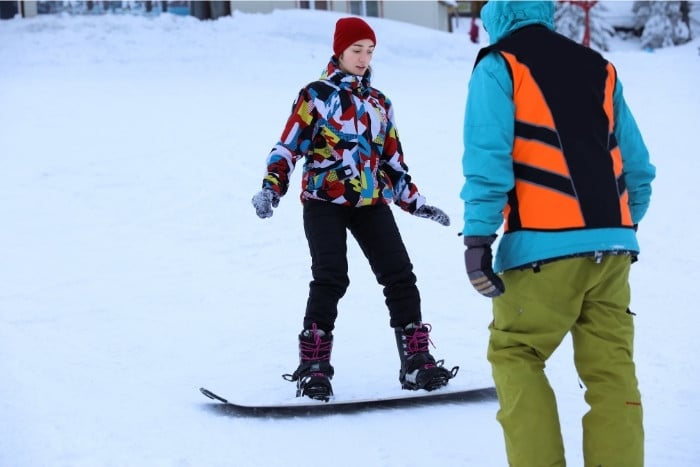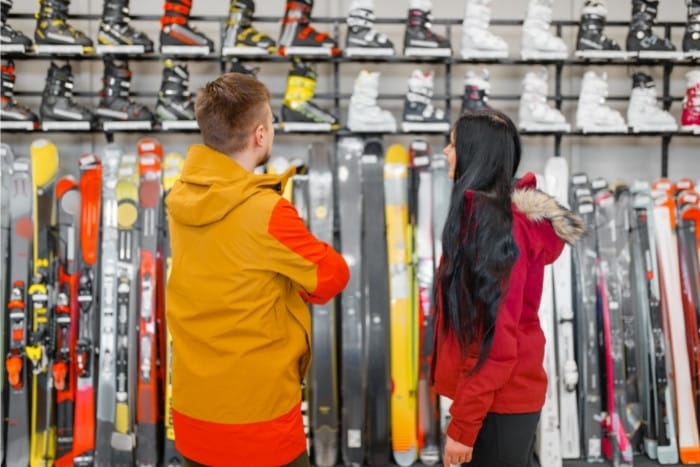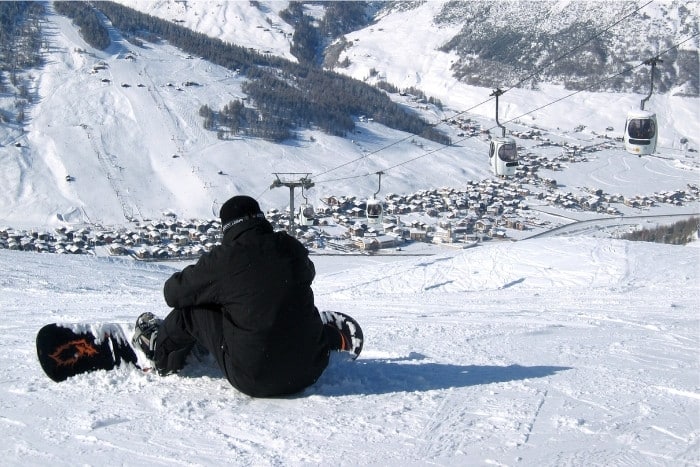It’s time to forget the middle-age spread and focus on the middle-age SHRED! Just because you’re a bit older than the average snowboarder doesn’t mean you can’t get into sideways sliding and have a ridiculous amount of fun.
There’s no reason why you can’t learn to snowboard in your 30s, 40s, and 50s or beyond. You may not be as fit as you used to be, but you can work on this. As long as you’re realistic about your physical capabilities, you can enjoy many years of snowboarding. You just need to approach it correctly.
In this post, I will go through the best approach to learning how to snowboard in your 30s, 40, and 50s. You’ll discover that it’s never too late to learn how to snowboard and what to expect when you first strap in.
Am I Too Old To Learn How To Snowboard?
Absolutely not! OK, you need to be realistic about your health and fitness. If you need a walking frame to get around, maybe snowboarding isn’t the best thing to do.
However, if you’re mobile and have no underlying medical conditions that are made worse by altitude, cold, and physical activity, there’s no reason why you can’t give snowboarding a try.
A few years ago, one of my local snowboard schools posted this video about Donald, who learned to snowboard at 73 years old.
Check it out for some inspiration if you’re concerned about snowboarding in your later years; this guy is a legend.
1. Book Some Lessons
There’s a good chance that you have a friend who has some experience as a snowboarder. These friends often offer their expertise to teach you how to snowboard.
The problem with this is that even if they are a great rider, they may be a terrible instructor. Getting a snowboard lesson from a family member or friend can result in a few scenarios.

Incorrect Instructions
Firstly, they could give you the wrong information, making your learning process more stressful. This could cause you to give up and rent some skis; we don’t want that.
Avoidable Stressful Situations
Your friend or loved one may overestimate your abilities and take you to a slope that’s too challenging for you. This is dangerous, but it can also cause heated arguments.
I’ve seen many girlfriends and husbands shouted at by their significant other for taking them out of their small comfort zone. There’s no need to risk a break-up; snowboard trips are supposed to be fun.
At the very least, it will make dinner in the evening pretty awkward.
Bad Habits
If you don’t learn the proper techniques, you’ll fall into bad habits. Many new snowboarders forget to bend their knees, counter-rotate to turn, don’t use the correct posture, etc.
If your friend doesn’t know how to prevent these errors, you’ll find it challenging to get out of bad habits, preventing you from progressing.
Considering these scenarios, it’s best to book some snowboard lessons. Your instructor may be more than half your age, but don’t let that worry you.
Snowboard instructors know how to approach each student and adapt their teaching techniques to help you progress.
There’s a much better chance of you getting through the day without shouting at each other too.
2. Practice Before Your Trip
Depending on where you live, you might be able to get some practice or some lessons before your trip. For example, you can book lessons at an indoor snow center or dry slope.
This will give you a head start before you head for the mountains, meaning you’ll be able to learn the basics and have more fun.
There are many tutorial YouTube videos you can watch before your trip.
Obviously, this isn’t the same as getting proper instruction, but there will be some things you can pick up and remember when you strap in.
3. Dress For The Occasion
If you’ve been skiing before, you’ll know how important it is to layer up your clothing. If not, layering starts with a base layer next to your skin.
Base layers are thermal underwear made from a technical fabric or merino wool. The material keeps you warm, wicks moisture away from your body, and dries quickly. This is essential for staying comfortable.
Your next layer could be a t-shirt (preferably technical) combined with a thin sweater or even a hoodie. Don’t wear anything too thick, as you’ll be working hard and getting hot.
You should then put a decent outer layer over the top of everything. This is your snowboard jacket and pants, which are waterproof and breathable, with some insulation.
You don’t need too much insulation unless you ride in arctic conditions. If your jacket is too thick, your movement will be restricted.
You may have some ski clothing you plan on wearing while snowboarding. There’s no problem with this, but you’ll want to upgrade to proper snowboard clothing soon.
However, you’ll benefit from wearing proper snowboard gloves and pants. These are designed to spend a lot of time in the snow, which is essential for a beginner snowboarder.
Your clothing should have a 10k waterproof rating, at least. If not, water will seep in, making you very wet and uncomfortable. I know this firsthand, as I wore cheap ski gloves while learning to snowboard.
It rained pretty much all week, and at the end of the day, I could wring my gloves out; they were useless.
4. Wear Protection
As you’re a bit older than the average snowboarder, you’ll understand the importance of self-preservation. Therefore, you need to wear a helmet, no matter your ability.
Helmets are also more comfortable than a beanie, as they don’t get wet when it snows and keep your head just as warm.
You can opt for more protection, but remember that the more stuff you wear, the hotter you’ll get, and the more your movement is restricted.
My dad (who still snowboards in his 70s) used to wear motocross body armor, impact shorts, wrist guards, and knee pads.
He also used to wear too many layers, so he was a sweaty mess by the time he got to the lift. He also struggled to strap into his bindings, as he couldn’t bend over.
It took me ages to persuade him to reduce the layers and wean him off his body armor. He enjoys snowboarding much more now he can move and not get heat stroke before lunch.
If you’re paranoid about hurting yourself, there’s nothing wrong with wearing protection. Don’t go all out; it can affect your performance and fun.
5. Should You Rent Your Equipment Or Buy?
It’s nice having your own snowboard equipment; I have a vast collection of snowboards to suit my mood and the snow conditions. But it’s better to rent as a beginner snowboarder.
Rental equipment used to be terrible, as you’d often get dated and poorly maintained boots, boards, and bindings. But now, you can rent the current season’s equipment from good snowboard shops.
Therefore, there’s a good chance you’ll have better equipment than your friends. At this early stage of snowboarding, you may not know what kind of snowboarding you want to do.
So if you buy your equipment, it may differ from the riding style you’re developing. The other thing about buying snowboard equipment is that you need something that suits your ability.
It’s best to start off with a short and flexible board, as they are forgiving and easy to turn. But you’ll soon outgrow a board like this.
If you buy equipment that is too advanced for you, you’ll find getting to grips with the sport more challenging.
When renting a snowboard, you can start with something easy and change it for something else as you progress.
Once you’ve got the bug and know what kind of snowboarding you want to do, buy your own stuff. However, buy some boots if you want to splash some cash on snowboard equipment.
Snowboard boots are the first thing you should buy as your snowboard and bindings should fit them, not the other way around.
Also, your own snowboard boots will form to the shape of your feet, making them more comfortable and giving you more control than rental boots.

6. Work On Your Fitness
There’s no doubt about it, the fitter you are, the better at snowboarding you’ll be, and you’ll enjoy it more. Snowboarding is a physical sport that calls on muscles you’ve probably never used before.
So about 8 weeks before you head to the mountains, start exercising. You need to work on your legs, so do lots of squats and lunges.
If your core is weak, you’ll find it hard to react to changes in the snow and pick yourself up off the snow. Therefore, do lots of core work, as you’ll have more control and less injury prone.
Flexibility is also a great way to get the most out of snowboarding. Being flexible will make learning how to snowboard much easier, and you’ll progress much faster, so start doing yoga and daily stretches.
7. Know When To Rest
Even though snowboarding is mainly sliding downhill, it’s surprisingly tiring, especially for a beginner. You’ll get tired at some point, which is when injuries happen.
There’s nothing wrong with taking it easy and stopping for a beer or hot chocolate to give yourself a rest.
It will help you stay on the mountain longer and allow you to reflect on what you’ve been doing while allowing your muscles to recuperate.
But don’t hang around too long, as your muscles will cool down and stiffen if you rest for too long, making it more difficult to get going again.
It’s also a good idea to take a day off or have half a day mid-week. This is usually when your legs feel fine, but you struggle to bring everything you’ve learned together because your body is tired.
So, halfway through your trip, take it easy, visit the spa, have a long lunch, and experience the other things on offer in the resort. You can also take a day off if the weather is terrible.
Not being able to see or getting freezing cold is not fun. Use these days as an opportunity to recover for another day. Snowboarding on the day after a good rest will be much easier.
Most people find that something clicks, allowing them to link turns and have more fun.
What To Expect When You Start Snowboarding
So there are no surprises; I’ll go into what learning to snowboard feels like. I’ll use my own experiences and situations I’ve observed in my time in the mountains.
1. The Learning Curve
Most people can link turns after 3 or 4 days on the mountain. Once you get past this stage, your life has changed for the better, and nothing is stopping you from mastering snowboarding.
But how quickly you learn how to snowboard largely depends on you. There are a couple of factors that will affect the learning curve.

Your Sporting Background
I mentioned earlier that fitness plays a large part in your snowboarding performance. But, if you have a sporty background, you’ll also find learning how to snowboard easier.
For example, if you’re an old skater, surfer, or wakeboarder, you’ll be able to transfer those skills onto the snow.
Your Mindset
Snowboarding well takes commitment. Of course, the more you do it, the better you’ll become, so practice is a large part of snowboarding. But, it’s also how you approach it with your mindset.
If you ride with purpose and commit to every turn, following your instructor’s guidance, you’ll become a great snowboarder sooner.
However, if you don’t commit or don’t strive for progression, you’ll never get past the bunny slopes.
2. Falling Over
Let’s face it, you’re going to fall over. But most of the time, these falls are minor, and you can barely feel the impact. However, falling on flat ground and ice is not pleasant, but it’s part of learning.
These falls teach you what you’ve done wrong, so they will happen less until you start pushing yourself.
3. The Feeling Of Getting It Right
Let’s imagine you’re a few days into your snowboarding career. Your turns are coming along, and then suddenly, something clicks, and you can link toe, and heel side turns all the way to the bottom of the hill.
I can guarantee you’ll be smiling the whole way down. Then you’ll celebrate with your friends over a few après beers. But this is just the first of many moments like this.
The next feeling of success will come when you start riding more challenging slopes.
By the end of your first snowboard trip, there’s a great chance you’ll take on blue and maybe even red runs, even if you don’t make it look pretty, but who cares?
4. Progression Beyond The Beginner Stage
Once your skid turns are dialed in, it’s time to carve.
Carving down easy slopes may only take a couple of days to achieve, but this will send you past the beginner stage toward being an intermediate snowboarder.
When done right, carving is an art form. However, it is the foundation of riding powder and freestyle riding.
When you can carve, it unlocks many doors, allowing you to get creative and provide access to experiences previously out of reach.
Final Thoughts
Learning to snowboard in your 30s, 40s, and 50s is not a silly idea. You may not want to hit the big jumps in the park, but you can still have a ridiculous amount of fun on the mountain.
Just make sure you’re prepared with the right equipment and clothing. Also, you’ll progress quicker and more safely by taking some lessons.
